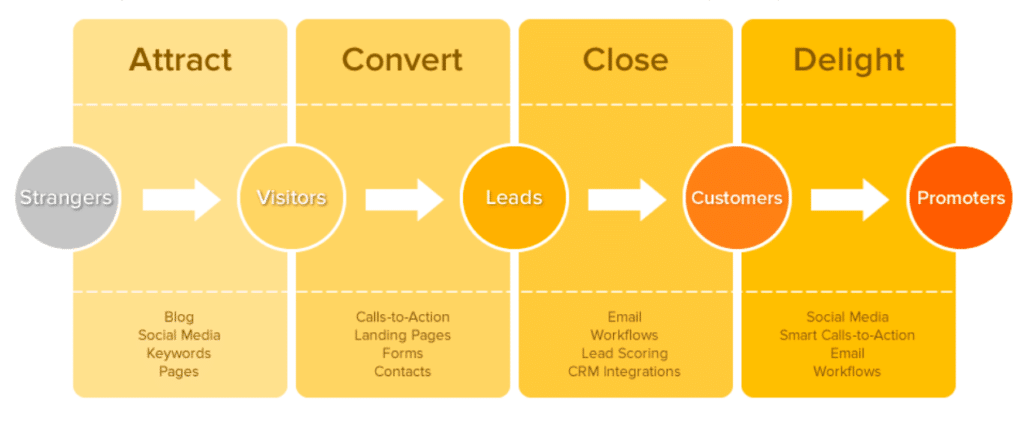The bottom of the graphic provides context on what types of marketing materials the prospect-turned-customer is likely to engage with at each stage of their journey:
- Attract (a.k.a. awareness) stage: press releases, print advertising, online ads. Maybe they receive a word-of-mouth referral.
- Convert (a.k.a. consideration) stage: marketing emails, landing pages, paid or social ads, company reviews, and product reviews.
- Close (a.k.a. purchase) stage: website content, company blog, chat with a sales associate, and sales collateral.
- Delight (a.k.a. customer stage): community forums, social community posts, customer success team chats, support content, and knowledge-base resources. Longer-term customers may receive promotions and newsletters.
Using customer journeys to enhance service
This concept is not new. In fact, companies like Medallia, which help massive corporate entities like T-Mobile, Sam’s Club, and Petco measure the success of consumer interactions at every stage of their customer lifecycle, have been mastering it for years. They focus on customer experience management and look for opportunities to measure and improve every moment the customer interacts with a brand – then operationalize their findings to bring them to scale.
To achieve this goal, companies like Medallia survey customers who have engaged with a brand across multiple channels – be it in-store, live chat, or phone support. Once collected, survey data is aggregated and used to identify bright spots. As a clear picture begins to surface, the survey works with their clients to develop best practices that can be rolled out more broadly.
The goal is to build a system that creates exceptional customer experiences – because amazing customer experiences create customer loyalty, which initiates the trickle effect. Loyalty inspires a good brand reputation and word-of-mouth marketing, which increases sales and profitability. This concept is so important that nationally recognized awards, like JD Power and Associates, were developed to recognize companies that take the time to get it right.
Now that you get the idea when it comes to customer experience mapping, it’s time to talk about employee journey mapping – which is essentially the same thing; only you’re mapping an employee’s experience at every stage of their tenure with your company.
Building an employee journey map
At the top of this post is a high-level example shared by Netsuite. But there are lots of ways to build an employee journey map. Here’s a fun list of 20 different visual examples. Some companies simply use time stamps. For example, you could use something like awareness, hiring, onboarding, year 1, years 2-4, and years 5+. You can also apply broad categories to each major stage of an employee’s journey. Below, we chose to focus on discovery, consideration, evaluation, acclimation, mastery, impact, autonomy – and for some, transition.
- Discovery: Potential employee gains awareness of your brand and a job that fits their skillset. They hear about and start to research your company.
- Consideration: Employee sees potential for a culture fit based on their research so they put in an application – and when offered an interview, they accept.
- Evaluation: During the interview process, the applicant determines whether the company is the right fit for their personal and career goals and aspirations. If they decide there’s strong potential, they accept your offer.
- Acclimation: During the onboarding process, the new hire adjusts to their role and gets acquainted with their team and new company.
- Mastery: As the employee builds tenure with the company, they reach a mastery phase and can add value to the organization by doing meaningful work.
- Impact: The employee develops autonomy and starts seeking out more opportunities to make an impact; e.g., via strategic ways to develop their career or by pursuing personal growth within the company.
- Transition: Some employees stay in the impact phase, but those who ultimately decide to pursue a new opportunity end up in the transition phase.
Once you determine which format works better for you – time stamps or stages, you can start mapping what the employee journey looks like in your organization based on how your business operates.
That’s how you build a comprehensive employee journey map in a nutshell. Now, let’s take a step back and look at it from a broader angle.
Watch what happens when you merge a customer experience map and employee journey map:
- Attract = Recruit. Attracting a new customer to your business is not so different than attracting a qualified employee. Much like a customer, prospective employees become aware that they’re open to new opportunities and start researching. They may get a word-of-mouth referral and decide to check out your business or might see a job posting and start researching. In either case, they’re likely to take a look at your company website, career page, Glassdoor profile, or LinkedIn business profile. If there’s real potential, the curious shopper will fill out a lead form or schedule a demo – or the prospective employee will submit an application.
- Convert = Hire. Converting a customer from consideration to close is very similar to interviewing and hiring a new employee. In either case, both the company and the prospect assess fit. When making a purchase decision, the consumer decides if a product or service fits their needs. In the case of hiring, a candidate determines if they’re a good fit for the open role and company (and vice versa). Both processes require homework, questions, analysis, evaluation, and feedback. If everything aligns, a purchase occurs, or a new hire offer is extended – and hopefully accepted!
- Close = Onboard. After you close a deal and bring on a new customer, the real fun begins. The same is true with a new hire. In both cases, it’s time for onboarding! At this point, your customer service team (or HR and people teams) are off to the races, doing all the necessary information gathering and getting your customer or new hire set up for success. To learn how to build a successful onboarding process, check out this free workbook.
- Delight = Engage. After onboarding, which can take several months, customers and employees alike become more autonomous. They learn what they need to know to be successful and reach out to team members less frequently for support. This is the stage when company culture and customer and employee experience really come into play. What does the day-to-day look like? Are employees and customers feeling positive about their decision to work with you? What changes can be made to improve the experience? Are there any toxic issues going on causing disruption? For both employees and customers, it’s important to solicit and analyze feedback on a regular basis to stay on top of any issues that could trigger the next stage…
- Churn = Resign. It’s never fun to lose a customer or an employee, but it is a good learning opportunity. Whenever possible, it’s a great practice to do a comprehensive exit interview with your employees. In the case of a customer, it’s good practice for customer success to meet with members of the team to understand what was lacking or what triggered the decision to end the relationship. In both cases, taking feedback to heart and using it to improve is invaluable to any company.
As you can see, when you start to think of an employee like a customer, you realize their journeys are a lot more similar than they are different.
Why modern people teams and top companies are turning to EJM
There’s a lot to be learned by mapping out the employee journey. Many companies are already doing this with the onboarding process, but few are mapping the experience all the way through the employee lifecycle. However, doing so can bring insights to light that will help companies improve their working environment and help build stronger relationships across the organization.
Many hypergrowth companies – particularly those in the tech space – have taken this process to heart, building People Teams or even assigning someone to the role of Employee Experience lead. In these companies, an entire department or position is wholly dedicated to performing constant analysis on the employee experience.
These folks diligently analyze whether or not the company’s policies and procedures meet the needs of the entire staff and look for opportunities to enhance the employee experience. It’s also essential to have a consistent gauge on how employees feel. Much like a company advocate can help a business, a disenchanted employee who tells anyone who will listen why a company is not-so-great has a similar (but negative) effect.
Companies like DoorDash have taken things a step further to build a link between the customer and employee experience. They require employees at all levels of the company to be a Dasher at least once a month. Understanding what everyone else is working to support brings perspective within the organization that can’t be taught via slide decks or all-hands meetings.
The bottom line is, companies that look at the big picture and evaluate customer and employee lifecycles, and those who prioritize ‘people’ roles, are putting significant effort into building loyalty and initiating the happy employee, happy customer cycle. When achieved, these companies are able to create brand and employee ambassadors who generate organic referrals and achieve scalable, predictable growth.





